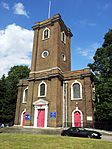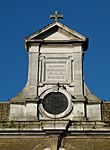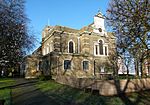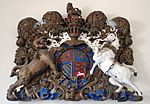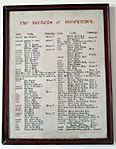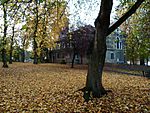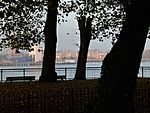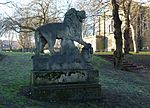St Mary Magdalene Woolwich facts for kids
Quick facts for kids St Mary Magdalene Woolwich |
|
|---|---|
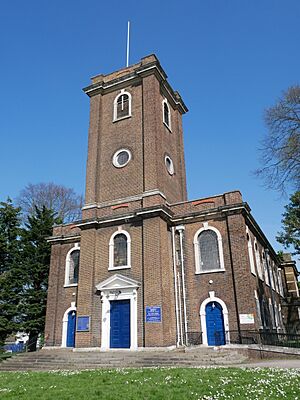
Southwest view of the church
|
|
| Location | Woolwich, Royal Borough of Greenwich, London |
| Country | England |
| Denomination | Church of England |
| Churchmanship | Central |
| History | |
| Status | Parish church |
| Dedication | Mary Magdalene |
| Dedicated | 9 May 1740 |
| Architecture | |
| Functional status | Active |
| Heritage designation | Grade B listed |
| Years built | 1732–1739 |
| Administration | |
| Parish | Woolwich St. Mary Magdalene with St. Michael and All Angels |
| Archdeaconry | Lewisham and Greenwich |
| Diocese | Diocese of Southwark |
| Province | Province of Canterbury |
St Mary Magdalene Woolwich is an old Anglican church in Woolwich, southeast London, England. It was built in the 1700s and is named after Mary Magdalene.
Contents
Discovering the Church's Past
Christianity has been in Woolwich for a very long time. In 2015, archaeologists found an old burial site from the late 600s or early 700s near the Thames River. It had 76 skeletons, which showed it was an early Christian settlement.
The first church in Woolwich was likely built before the Normans arrived in 1066. It was dedicated to Saint Lawrence. This early church stood on a small hill north of where the current church is today.
For about 150 years, from the early 900s to the mid-1100s, Woolwich was controlled by a monastery in Belgium. Around 1100, King Henry I gave the church to the Bishop of Rochester. It was probably around this time that the church was rebuilt using stone.
Changes to the Church's Name
The parish church was first named after Saint Lawrence. Later, in the 1400s, it was dedicated to the Virgin Mary. Then, about 100 years later, it was renamed for Saint Mary Magdalene. The first known leader of the church was John Chaplain in 1182.
In the late 1300s, a church leader named William de Prene rebuilt the bell tower. In the early 1500s, another leader, John Sweetyng, helped build the famous ship Great Harry at Woolwich Dockyard.
Building the New Church
By the 1700s, the old church was in bad shape. Its spire had fallen, and the foundations were weak. So, a new church, the one you see today, was built from 1732 to 1739. It was built very close to the old medieval church's spot.
The name of the architect who designed it is not known. The new church was partly paid for by a special group called the Commission for Building Fifty New Churches. A bricklayer named Matthew Spray built it, using over 636,000 bricks! The church was officially opened on May 9, 1740. After that, the old church was taken down, and its churchyard was made bigger.
Later Changes and Modern Times
In 1875, Adelbert Anson became the church leader. He wanted to build a new church, and several architects drew plans, but nothing happened. His successor, Samuel Gilbert Scott, then planned for a new chancel (the area around the altar) and vestries (rooms for clergy). These were finished in 1894.
Around the same time, the churchyard was turned into a public garden. Some changes were made inside the church in 1924.
The church was not badly damaged during World War II. In 1954, it was given a special "Grade B listed" status, meaning it's an important historic building.
In 1960, a new and creative church leader named Nicolas Stacey arrived. His "Woolwich Project" (1960–1968) brought many new ideas to the church. For example, he had parts of the church closed off with frosted glass to create a cafe and offices. He also turned the crypt (an underground room) into a youth club. The "Coffee House" was opened by Princess Margaret and Antony Armstrong-Jones in May 1961.
In the 1970s, St Mary Magdalene's parish joined with two other churches in Woolwich. Some repair work was done in 1977. In 2008, the glass panels were removed, making the inside of the church feel open again.
In May 2019, St Mary's Church and its gardens became part of a special "conservation area." This means the area is protected because of its historical importance.
The Church Building
Outside the Church
The church stands on a small hill that reaches north towards the Thames River. It is built of brick with special Portland stone details around the windows and edges.
The bell tower sticks out from the front of the church. It has a flat top without a tall spire. The brick chancel, added in 1894, has Bath stone decorations and a triangular top.
Inside the Church
The church has a large main area called a nave with five sections. It has rows of columns, similar to another church in Deptford. There are two side aisles with galleries (upper levels) and some additions from the 1800s. These include the chancel, the Lady Chapel (a smaller chapel) to the south, and the organ room to the north.
The Lady Chapel holds the rare iron tomb of Henry Maudslay, a famous engineer. He designed his own tomb!
The inside of the church is painted light blue and white. This includes the large red stone columns near the chancel and the smaller columns around the east window. The royal coat of arms from 1740 used to hang above the altar. Now, it is kept in the entrance area under the tower.
The pipe organ was made in 1754 and was first placed in the west gallery. After the new chancel was built in 1894, the old wooden screen (called a reredos) from the old chancel was moved to the south chapel. Above it is a stained glass window made by Herbert Hendrie in 1922.
A special moving pulpit (a raised stand for speaking) was added in 1899. It is made of walnut wood with pretty designs. People helped pay for it to celebrate Queen Victoria's Diamond Jubilee.
St Mary's Garden
The churchyard is now a public park called Saint Mary's Garden. It was designed in 1893 by Fanny Wilkinson, who was Britain's first professional woman landscape gardener. Her design includes gravel paths, grassy areas, and old trees. You can still see some old gravestones along the northeastern edge.
Near the gravestones is the tomb of bare-knuckle boxer Tom Cribb, who lived in Woolwich. His tomb looks like a sad lion resting its paw on a pot.
Stairs lead up to the park entrance from Woolwich Church Street. Other entrances are on Church Hill, St Mary Street, and John Wilson Street. Two viewing spots, called belvederes, offer great views of the Thames River and the Woolwich Ferry. However, new tall buildings are starting to block some of these views.
In the early 1960s, the park was made bigger and redesigned by G.P. Youngman. He added new paths, raised flower beds, and rock gardens. Some things were moved, like a drinking fountain and several tombs, including that of engineer Henry Maudslay.
See also
- Saint Mary Magdalene Church of England All Through School


